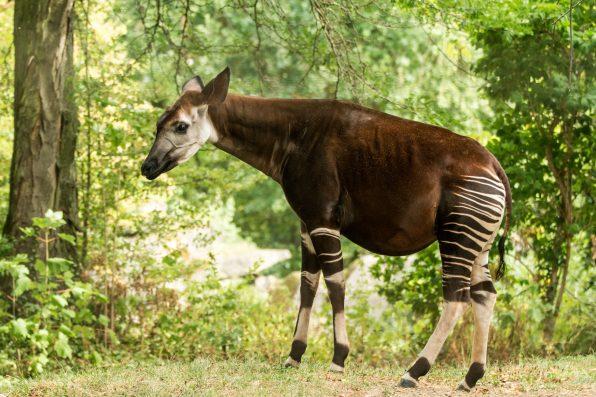This Unique Animal Known As An Okapi Might Look Like A Zebra, But It’s Actually The Only Living Relative Of The Giraffe

At first glance, the okapi, with its black and white striped hindquarters and a body shaped like a horse, appears to be a close relative of the zebra. In reality, the okapi is related to the giraffe!
In fact, it’s the only living relative of the giraffe. If you take a closer look, you might start to see the resemblance between the two animals.
Like a giraffe, the okapi has a long neck, large, perky ears, and cloven hooves. It even has a dark, extra-long, flexible tongue like a giraffe’s for stripping trees and shrubs of their leaves. Fun fact: the okapi is among one of the only mammals in the world that can lick its own ears!
Okapis are native to the dense rainforests of the Democratic Republic of the Congo. While indigenous populations have known of the okapi’s existence for many years, Western scientists didn’t discover the animal until the 1900s.
You might be wondering why okapis have zebra-like stripes. Wouldn’t they stand out like a sore thumb in a tropical rainforest? Actually, their markings provide great camouflage when they stand in the sunlight that filters through the thick, lush greenery of the forest.
Their bodies are covered in oily reddish-brown fur that causes water to slide right off, effectively keeping them dry on rainy days. They also have a keen sense of hearing and smell.
Okapis have scent glands on their feet that leave behind a sticky, tar-like substance, which lets them communicate to other okapis that they are passing through the area. Each okapi has a unique scent, so they can tell who is who.
As for diet, they can eat forty to sixty pounds of twigs, leaves, and fruit per day. They also eat clay from riverbeds, which gives them minerals they cannot obtain from vegetation alone.
A female okapi usually gives birth to one baby at a time. Newborns can stand within thirty minutes of being born, but they don’t defecate until they’re between four to eight weeks old.

Ji – stock.adobe.com- illustrative purposes only
This serves as a defense tactic from predators since they won’t be able to track the smell of feces, allowing newborn okapis time to grow and gain strength. Okapis reach full adult size after three years and can live for up to twenty to thirty years.
Generally, they are solitary creatures that like to travel alone and keep to themselves. Due to their shy and secretive nature and the fact that they’re an endangered species, it isn’t likely you’ll encounter one in the wild.
Their biggest threats include mining, oil drilling, deforestation, and hunting. Only about 25,000 okapis are estimated to be alive today. The Okapi Conservation Project and other conservation organizations are working to protect the okapi’s natural habitat.
If true crime defines your free time, this is for you: join Chip Chick’s True Crime Tribe
How To Decorate Your Home In The Art Deco Style
Sign up for Chip Chick’s newsletter and get stories like this delivered to your inbox.
More About:Animals